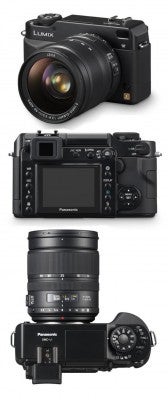Panasonic today announced details of its first digital SLR camera. Based on the four-thirds system, the Lumix DMC-L1 features a 7.5MP Live MOS sensor with full time live view, and a newly developed Leica 14-50mm image stabilised zoom lens.
Panasonic today announced details of its first digital SLR camera. Based on the four-thirds system developed by Olympus, the Lumix DMC-L1 features the new 7.5MP Live MOS sensor first seen in Olympus? E330 camera, which offers full time live view to its 2.5? LCD screen. Other key features include a newly developed Venus lll processor and, significantly, a Leica 14-50 f/2.8-3.5 zoom lens, Leica?s first interchangeable digital SLR lens and its first with a built-in optical image stabiliser.
Although superficially similar to the Olympus E330, and sharing several jointly developed components, the L1 follows a very different philosophy in its design approach to any other digital SLR currently available.
Reminiscent in some ways of the company’s earier LC1 rangefinder camera, its classic design ethos seems aimed at the connoisseur, with features such as a traditional shutter speed dial on the top plate, adjustable in third-stop increments, and a traditional aperture ring on the lens. Panasonic claims that this offers a more intuitive and enjoyable experience for the photographic enthusiast.
No price has been given for the magnesium-bodied L1, but the very high quality of its design and construction, and the addition of the Leica lens, would suggest that this will not be an entry level SLR. Availabily is vague at the moment, with Panasonic quoting a shipping date ?some time in 2006?. Here are the key features (summarised from the Panasonic press release):
A shutter speed dial on the camera body and an aperture ring on the lens barrel
To enhance the sense of camera control, the DMC-L1 features a shutter speed dial on the camera body. The LEICA D VARIO-ELMARIT 14-50mm/F2.8-3.5 lens is equipped with an aperture ring, in addition to a focus ring and zoom ring, for easy, direct aperture setting.
Full-time Live View for a whole new style of digital SLR shooting
By combining the full-time image output function of the Live MOS sensor and a mirror-up mechanism, the DMC-L1 achieves a full-time Live View function that displays the image on the LCD directly from the sensor signal. This function can be selected in both Auto Focus and Manual Focus modes. In Manual Focus, it allows the user to enlarge an image within the frame and then select the area focusing. This makes it easy to check the focusing condition on the large 2.5-inch, high-resolution, 207,000-pixel LCD. The depth of field can also be easily checked by pressing the Aperture button.
High-image-quality, low-energy-consuming 4/3-type Live MOS sensor with 7.5 million pixels
The Live MOS sensor used in the DMC-L1 not only makes full-time Live View possible, it also helps capture images with delicate gradation and a wide dynamic range. And it suppresses energy consumption as only a CMOS sensor can do. Noise is also minimized thanks to a special processing technology that runs on voltage as low as 5V.
Venus Engine Ill LSI: High image quality, quick response, low energy consumption
The Venus Engine III is an image processing LSI that was newly developed to maximize the performance of the Live MOS sensor. While inheriting the earlier Venus Engine?s high resolution, superior colour reproduction and detailed gradation, the Venus Engine III also reduces noise to the level expected from a digital SLR camera, to help render smooth images. The Venus Engine III improves camera responsiveness too, supporting high-performance consecutive shooting and a short shutter interval. Despite the considerably higher performance, the Venus Engine III consumes only 80% as much power as the Venus Engine II. This combines with the Live MOS sensor?s low energy consumption to provide longer battery life.
Dust reduction system to prevent annoying contaminants
The most critical and annoying problem with digital SLRs with interchangeable lenses is the possibility of dust getting inside the camera during lens changes, contaminating the image sensor. If this happens, professional cleaning is often required. The DMC-L1 takes care of this problem by incorporating a Supersonic Wave Filter dust reduction system. The system uses supersonic vibration to instantly shake off any dust that might otherwise affect the image.
Panasonic original home networking
Like all LUMIX models, the DMC-L1 is compatible with the SD Memory Card. It also is compatible with the mass-storage SD standard based on FAT32, including the upcoming super-high-capacity SD Memory Cards of more than 2 GB (SDHC).
World’s First Leica Interchangeable Lens with Optical Image Stabilization System Designed for Digital SLR Cameras
Featuring a focal length from 14mm to 50mm_(35mm equivalent: 28mm to 100mm), the new LEICA D VARIO-ELMARIT 14-50mm/F2.8-3.5 ASPH lens is the first interchangeable lens from Leica developed exclusively for digital SLR cameras. The lens comprises 16 elements in 12 groups, including two aspherical lenses and advanced optical image stabilization system.





